
Redesigning forest garden beds
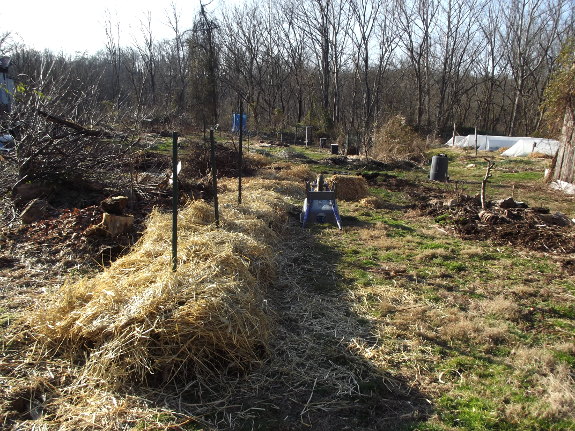
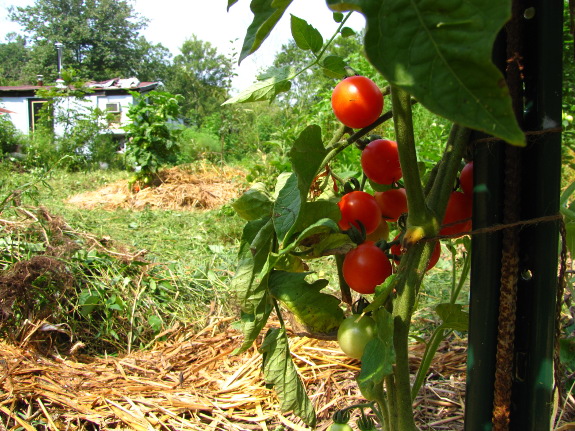 In an effort to prevent
myself from ignoring
the forest garden again this year and letting it turn into a weed jungle, I'm making a lot of changes.
In an effort to prevent
myself from ignoring
the forest garden again this year and letting it turn into a weed jungle, I'm making a lot of changes.
The first step is to
incentivize working in the forest garden during the growing
season. To that end (and because our tomatoes did so well there
last year), I'm making lots of new beds to plant tomatoes and butternut
squash into. You can see part of this year's tomato alley at the
top of the page.
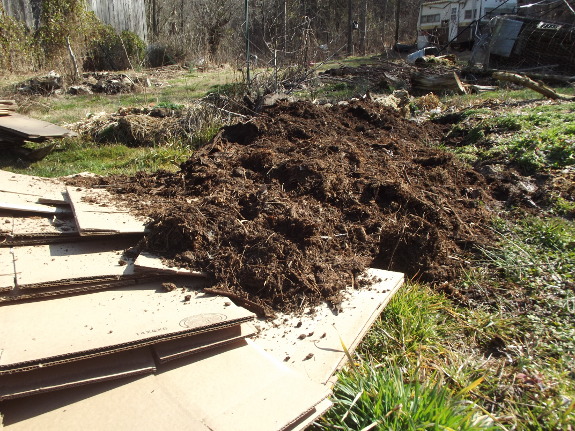
I built the new beds by
simply wheelbarrowing partially rotted compost out of the chicken
pasture and topping it off with straw. There are very few
perennial weeds in the areas I chose because the waterlogged soil is so
terrible nothing can survive unless I raise the plants' roots up out of
the wet. I figure that making these extremely simple kill
mulches now will ensure that most weeds have died by May, but I can
always come back through and add cardboard beneath the straw if
anything starts to poke up through. (As you can see, I did add
cardboard in select areas where perennial weeds were evident.)
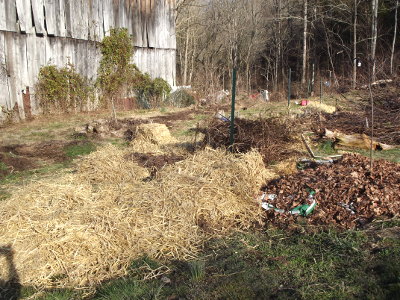 Since
they're in the forest garden, the new beds serve double duty.
This year, they'll be part of the vegetable garden, but each one is
attached to a tree mound, and as the tree grows, more and more of the
bed's growing area will be mulched with leaves instead of straw and
given over to tree roots. A modified version of this expanding
tree mound technique has served me well in the forest
garden island.
Since
they're in the forest garden, the new beds serve double duty.
This year, they'll be part of the vegetable garden, but each one is
attached to a tree mound, and as the tree grows, more and more of the
bed's growing area will be mulched with leaves instead of straw and
given over to tree roots. A modified version of this expanding
tree mound technique has served me well in the forest
garden island.
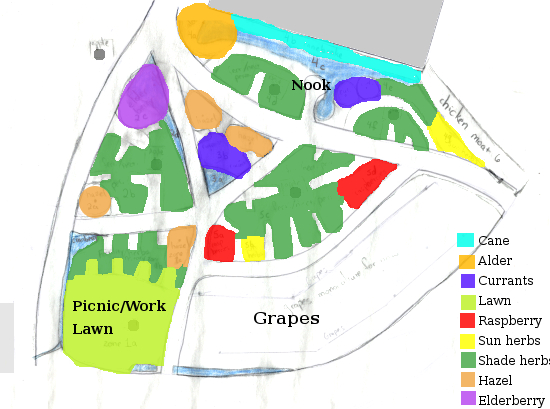 My original plan involved building keyhole beds surrounding the fruit trees,
but I've ditched that goal as I learned more about my own gardening
style. Yes, keyhole beds seem to make a lot of sense as a way of
expanding a circular tree mound, but they're tough to maintain if you
have to mow the aisles. Instead, I'm making all of my new beds
linear and leaving plenty of room for the mower to fit in
between. I'll probably fill in aisles as the trees overshadow
them, ending up with solid raised beds in the seldom-trampled areas
under trees.
My original plan involved building keyhole beds surrounding the fruit trees,
but I've ditched that goal as I learned more about my own gardening
style. Yes, keyhole beds seem to make a lot of sense as a way of
expanding a circular tree mound, but they're tough to maintain if you
have to mow the aisles. Instead, I'm making all of my new beds
linear and leaving plenty of room for the mower to fit in
between. I'll probably fill in aisles as the trees overshadow
them, ending up with solid raised beds in the seldom-trampled areas
under trees.
In case this post makes
the forest garden project sound well thought out, let me hasten to add
that I was really just playing around in the sun Friday, making it up
as I went along. By the end of the summer, I'll know if my
seat-of-my-pants changes made sense or not.
Want more in-depth information? Browse through our books.
Or explore more posts by date or by subject.
About us: Anna Hess and Mark Hamilton spent over a decade living self-sufficiently in the mountains of Virginia before moving north to start over from scratch in the foothills of Ohio. They've experimented with permaculture, no-till gardening, trailersteading, home-based microbusinesses and much more, writing about their adventures in both blogs and books.
Want to be notified when new comments are posted on this page? Click on the RSS button after you add a comment to subscribe to the comment feed, or simply check the box beside "email replies to me" while writing your comment.

I apparently hadn't seen your garden plan before, but I have to say, I'm glad I'm not the only one that has mapped out my future garden in such detail! I have an illustration very similar to yours (that I drew in Gimp on top of Google's aerial image), and after I finished adding all the garden beds, wildflower islands, fruit trees, ground covers, and paths, I stood back, examined it, and concluded that I had totally gone off the deep end. I don't have the botany expertise that you do to know what will work best for long-term permaculture goals, and admittedly, some of it is based partly on aesthetics, but I did stick to native and heirloom varieties and took both crop rotation and companion planting into account. I'm sure it will be modified as I figure out what works and what doesn't, but I've found that I do best in the garden when equipped with a detailed plan of action. And it's fun to plan!
~ Mitsy
OK, I have to mention this because since you adore maps like I do, I'm guessing aerial imagery might be an obsession, too. I just re-checked our property on Bing maps (I like to consult Google, Yahoo, and Mapquest, too), and they've updated their aerial imagery with fantastic new resolution, so you might want to check it out. Now I must go re-do my garden planning using this new imagery, lol...
~ Mitsy
Cool! It's interesting to compare Bing maps to Google's satellite feature. For our farm, Google is more useful since it zooms in further, but Bing is clearly more up to date! I can tell that google's images for our farm are from five years ago because I'm just beginning to lay out our berry patch, while Bing looks like it might be from this past fall. (You can see my cover crops in the back garden!)